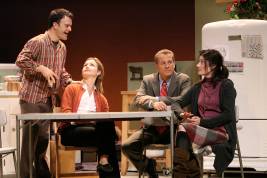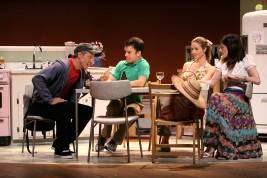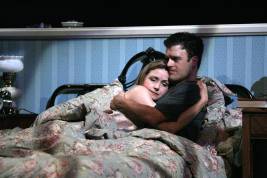
There’s a moment in Donald Margulies’ Dinner With Friends when one of its characters comments, “The thing is, you never know what couples are like when they’re alone; you never do.”
The truth of this is made amply clear in Margulies’ 2000 Pulitzer Prize winning play, now being given a smashing revival by McCoy Rigby Entertainment at the La Mirada Theatre For The Performing Arts. Like flies on the fourth wall, Margulies allows us to observe Gabe and Karen’s (and Tom and Beth’s) most private moments. In addition to our own perceptions of each of them, Margulies lets us see each couple as they see the other, and what they see is often quite different from the other couple’s intimate reality.
40something Gabe (Kevin Weisman) and Karen (Melanie Lora) have invited their two closest married friends for dinner, but Beth (Cate Cohen) arrives sans Tom (Patrick Fabian). With their kids and hers upstairs watching a DVD and Gabe and Karen going on about this and that, Beth suddenly breaks down and confesses that Tom is not really away on business. He’s left her, after twelve years of marriage, for a stewardess. (Actually, she’s a travel agent, but Beth refuses to afford her that slightly more prestigious title.) Gabe and Karen are aghast. Tom and Gabe have been best friends since college, and Gabe and Karen introduced Beth to Tom a dozen summers ago.
Tom shows up later to tell his side of the story, and in Rashomon fashion, each has an entirely different take on reality. Whereas Beth sees Tom’s affair with the “stewardess” as an unjustified betrayal, Tom views this as a logical consequence of Beth’s coldness. She never touches him anymore, he tells his friends. Tom even performed an experiment to prove this. For a week, he refrained from touching her, to see if she would give him a simple caress. She didn’t.
Ironically, Tom and Beth’s sex life is hotter than ever, as we see for ourselves when a fight in the bedroom leads to passion of a different sort.
Only once do we see all four characters on stage together, and that is a flashback to the day Beth was introduced to Tom at Gabe and Karen’s summer house in Martha’s Vineyard, a scene which reveals just how much Gabe and Karen have invested in Tom and Beth’s becoming a couple. No wonder each of them (and especially Karen) feels personally betrayed by their friends’ breakup. There may even be a bit of jealousy there, especially after Beth too finds a lover. With both Tom and Beth enjoying the best sex of their lives, how can an old married couple find similar excitement in the bedroom?
In Dinner With Friends, playwright Margulies lets us see how different each character’s perception is of his or her own situation and those of the other three. Beth claims not to have had an inkling that Tom was going to leave her. Tom maintains that the signs were there all along, that he was trying to communicate his dissatisfaction, but she refused to “hear” him. Karen won’t even consider the possibility that Tom may be in the wrong. “You do something like this,” she tells Gabe, “and you are outta here!” Gabe is better able than Karen to see both sides of Tom and Beth’s story.
The playwright has bigger issues on his mind as well. How long can one reasonably expect a marriage to last? Have Gabe and Karen stayed together out of a fear of change, or simple inertia? Are Tom and Beth taking the more honest route in calling it quits after a dozen years together? Will Gabe and Karen be able to maintain their friendships with Tom and Beth now that the latter are no longer a couple? Will Tom and Beth’s breakup lead to a weakening (or strengthening) of Gabe and Karen’s marriage?
Director Brian Kite virtually insured this production’s success in casting a quartet of actors who are not only a perfect fit for their roles, but also a perfect fit with each of their costars. It’s easy to believe in each married couple’s relationship with his or her partner. It’s equally easy to believe in the feelings (ambivalent or otherwise) that each one inspires in the other three.
Kite gets richly layered, finely nuanced performances from this terrific ensemble.
As was also the case in South Coast Rep’s production of another Margulies gem, Collected Stories, the casting of “girl next door” Lora as Karen works to perfection. Because we like her instinctively, her rigidity in the name of “principles” comes as a bit of a shock. Lora lets us see the cracks beneath Karen’s seeming contentedness as well as the conflict between her desire to maintain the status quo and the envy she can’t help feeling for the possibly more satisfying route Beth has taken.
Weisman, a memorable Uncle Louie in last year’s Lost In Yonkers, returns to La Mirada as Gabe, the play’s “good guy,” painting the portrait of a man who, unlike Karen, is able to see both sides of his friends’ breakup. He’s particularly fine in a scene in which Gabe reacts with lines like “Lucky you” to Tom’s ecstatic description of his new relationship, letting slip his envy for Tom’s new life and his doubts about his own, doubts that Gabe tries to keep hidden from the world and perhaps even from himself.
Casting the dashing Fabian as Tom was a perfect choice for the man who ended up snagging all the women Gabe was interested in back in college. Fabian is far more than merely a handsome face, however. Like his castmates, he too shows us the deeper person within. With characteristics of both victim and villain, Fabian’s Tom is someone whose search for an “authentic” life is sure to resonate with many in the audience.
Completing the cast as Beth is the marvelous Cohen, not afraid to show us Beth’s less sympathetic side in her initial meeting with Tom all those years back. Like Lora, Cohen is so innately likeable that we also take her side initially. Once we’ve observed the complex mix of self-righteousness, resentment, and self-doubt that Cohen reveals, we (like Gabe and Karen) begin to have our doubts.
Margulies’ script sets seven scenes in seven different locations. Scenic designer extraordinaire John Iacovelli’s ingenious use of a revolving set solves this potential staging problem, allowing quick scene changes (besides looking absolutely smashing). Costumes by Dwight Richard Odle, lighting by Craig Pierce, sound design by Cricket S. Myers, and property design by Terry Hanrahan complete the all-around top-drawer design package, as fine as you’re likely to see in any regional theater. Jill Gold is production stage manager.
Dinner With Friends brings the 2009-2010 La Mirada/McCoy Rigby season to a close on a high note. Kudos to Tom McCoy and Cathy Rigby for challenging their audiences with this entirely adult drama, one that is likely to resonate with anyone who’s ever been married (happily or not) or observed other people’s marriages (happy or not) and wondered, “What’s really happening behind those doors?”
La Mirada Theatre for the Performing Arts, 14900 La Mirada Boulevard, La Mirada.
www.lamiradatheatre.com
–Steven Stanley
June 5, 2010
Photos: Michael Lamont





 Since 2007, Steven Stanley's StageSceneLA.com has spotlighted the best in Southern California theater via reviews, interviews, and its annual StageSceneLA Scenies.
Since 2007, Steven Stanley's StageSceneLA.com has spotlighted the best in Southern California theater via reviews, interviews, and its annual StageSceneLA Scenies.







 COPYRIGHT 2024 STEVEN STANLEY :: DESIGN BY
COPYRIGHT 2024 STEVEN STANLEY :: DESIGN BY